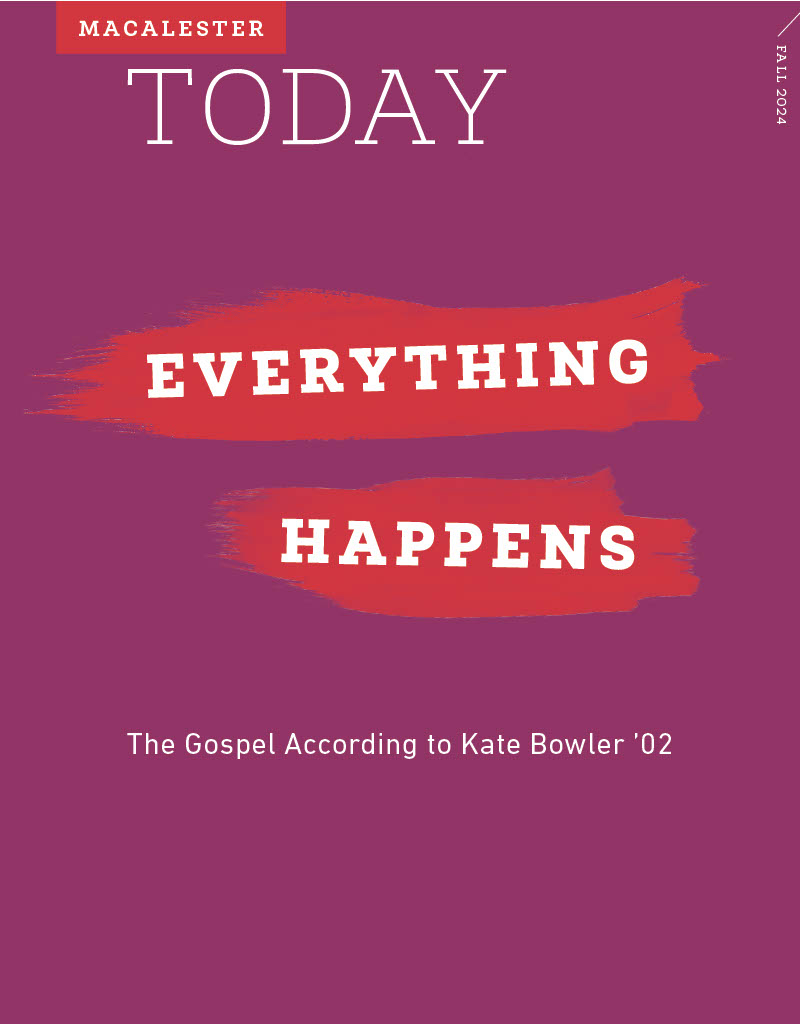
By Michael Householder
For seventy-five years—roughly half of the college’s history—the Macalester College Pipe Band has provided the campus’s signature sound, piping in graduates at Commencement, inspiring Mac’s athletes, and leading alumni to their Reunion dinners. It also embodies a distinctive feature of Mac’s culture, one rooted in Midwestern attitudes toward achievement: it’s OK to strive, but don’t take yourself too seriously.
From its inception in 1948, the Pipe Band has been viewed as both a kind of cultural cosplay curiosity and as a source of pride. “Anybody who can dash up to the third floor Old Main without panting like a hound after the chase,” an announcement in the Mac Weekly began, “is urged to join the bonnie lassies and laddies who will blow the bagpipes in a proposed College kiltie band.” It concluded on a more serious note. “If such a band can be organized… Macalester will be able to boast of a feature for which there is nothing comparable at any other college in the state.”
Bigger and better than ever, the Pipe Band today is not only unique among colleges in Minnesota, it just might be the best darn college pipe band in America. As the college concludes its sesquicentennial year, here is a look at the Pipe Band’s origins and long history.
Before 1948, when journalism professor Ivan Burg ’34 pitched the idea of a pipe band to his class, the college didn’t embrace its Scots identity the way that it does today. There are few references to bagpipe music or other aspects of Scottish culture on campus.
If anything, bagpipes were viewed as an oddity. An item in the May 1897 College Echo noted that “a daylight serenade… of several bag-pipes” had been heard on campus. To underscore the ridiculousness, the report noted that the “wanderers” were accompanied by a monkey.
The first reference to bagpipes as an instrument of school spirit appeared in a January 1938 letter to the student forum section of the Mac Weekly. The writer called on their fellow students to “show our athletic opponents that Macites have as much pep as the best of them” by adopting a few “Scotch yells” and dressing their “bonnie rooter kings in plaid kilts,” even suggesting—perhaps tongue only lightly in cheek—that bagpipes could be added to the pep band.
What started as a joke, however, quickly garnered genuine interest. The next week, the Mac Weekly reported that a “Hoot Mon” yell had been introduced “in accord with the recently advanced Scotch theme” and that additional Scots-themed cheers were being prepared. As evidence of the popularity of the new theme, the paper quoted a student who was at the game: “The Scotch yell went off big last Saturday night—it really ‘kilt’ ‘em.”
The faculty and administration were also looking toward Macalester’s Scots heritage as a way to boost school pride. In March 1938, the very first Founding Day celebration was organized. In its announcement of the celebration’s program, the Mac Weekly noted that, in addition to the speeches and presentation of a birthday cake “big enough to serve 400 people,” the event would include the “introduction of Scottish tradition in the form of wearing Scottish bonnets and ties [and the] singing of Scotch songs.” Attendees were asked to wear “plaid neckties, dresses, or any other plaid effects available.”
As for Scots music, the article noted that “A search of the Twin Cities for bagpipe players” was underway. While there is no record of pipes at the inaugural celebration, they quickly became established as a key component of future Founding Days. In 1939, the fifty-five-pound birthday cake was carried by four students in Highland dress, accompanied by a piper. In 1941, a first-year student and native of Scotland, William Knowles ’48, played the pipes during the procession.
World War II suspended campus frivolity. Knowles left Macalester to serve three years with the Army’s 90th Infantry Division in Germany and later graduated with the Class of 1948. He often returned to campus to play as an alumnus.
With the war now behind them, Macalester community members were eager for lighthearted fun. By the time Burg pitched his idea to his journalism students, the campus was ready. What a decade earlier had appeared as a kind of quaint novelty now felt like an essential component of the school’s identity, and the idea of using bagpipes to promote school spirit returned.
To grow that spirit, the college could not rely on scouring the Twin Cities for guest pipers, or count on having an accomplished piper enrolled as a student every year. It needed a student organization that could figuratively blow new life into these traditions and sustain them, even as classes of students graduated and tastes evolved over the decades.
In its proposal to form the Pipe Band as a formal student club, the organizers noted this need. “[F]or more than twenty years,” they wrote, “the faculty, alumni, friends, and students have been looking for something that will typify and emphasize the Scottish tradition associated with the name of the college. [A] SCOTCH BAGPIPE BAND presents a unique opportunity for ever-widening service to Macalester College.”
In addition to inspiring his students with his vision, Burg was instrumental in securing the resources they needed. He requested funding from President Charles Turck, who in turn persuaded the Board of Trustees to purchase instruments and uniforms. Burg also wrote to the chief of Clan Macalester, Lt. Col. Charles Macalester, who gave the college permission to wear the official clan tartan. He even referred Burg to his personal kiltmaker so that the band could get its first set of outfits.
While Burg worked on acquiring equipment, students had the harder task of learning how to play. To get the band going, students with no prior experience playing bagpipes or drums were encouraged to join. The only requirement was that they attend weekly practice and make the band their primary extracurricular activity. For the first several months, they learned tunes on practice chanters, basically the blowing and fingering portion of the instrument. Only later would they be ready to graduate up to the full Highland bagpipes with their fiddly drone reeds and hard-to-keep-inflated bladders. Student participation helped the band survive, despite having to replenish its membership every year.
William “Bill” Williams ’52 was named the band’s first pipe major. Adam Mitchell, a local bagpiper, volunteered to direct the band and instruct new pipers. Under their leadership, the band quickly established itself. They accompanied the now traditional presentation of the Founding Day birthday cake in May 1950. They made their first appearance at the head of the Commencement processional that June. That fall, the band played in its first homecoming parade.
In addition to adding energy to the campus, the band attracted attention in the wider community. The Minneapolis Sunday Tribune ran a feature story with color photographs. A sidebar noted that, due to the creation of the band, Roy Richardson ’52, a “national junior bagpipe champion of US and Canada, transferred from Northwestern to Macalester.”
The band became a mainstay of campus life. On top of its regular cycle of ceremonial performances, it played at football games and offered occasional concerts.
While most pipe bands of that time, partly due to their martial roots, were dominated by men, the band at Macalester attracted women from the outset. Photographs of the band in the early 1950s show an almost all-female pipe corps, led by pipe major Pat Freeburg ’56. She applied to Macalester specifically so that she could join the band, having been inspired by a performance of Brigadoon featuring a Macalester piper at St. Paul Central High School. Asked about the novelty of a pipe band composed mostly of women, Freeburg notes that because the band was still new, it was open to everyone. “We [women] wanted to be part of something!” she laughs.
Throughout the fifties and sixties the pipe band continued to provide the sound for ceremonial events, as well as serve as community ambassadors, playing at St. Paul’s Winter Carnival, marching in various parades, and even performing at a 3M event celebrating its signature
Scotch Tape.
Despite the cultural changes that swept college campuses in the 1970s, the pipe band played on. In 1973, a new tradition was introduced to campus when for the first time it hosted the Minnesota Scottish Fair and Highland Games. Although the band had participated in some piping competitions previously, the availability of a local contest further developed this aspect of the band.
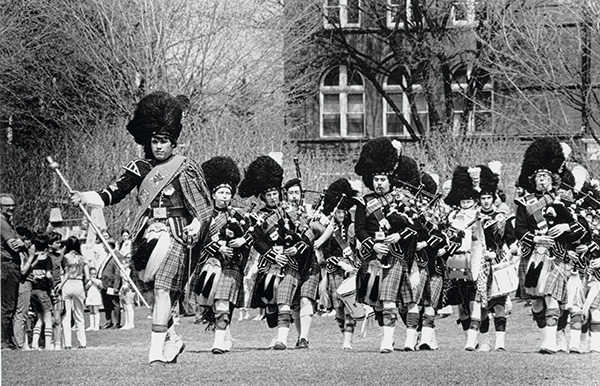
The eighties and nineties witnessed some other changes as well. First, following the practice of other competition bands worldwide, the band swapped out its traditional Highland dress, with its heavy jackets, sweeping plaids, and bulky belts, for the more lightweight kit members wear today.
Second, to ensure sufficient membership and consistent playing, even as students graduated and new players learned their instruments, the decision was made to merge the band with another local outfit, the City of Minneapolis Pipe Band. This merger established the mixed membership of students, alumni, faculty, staff, and local community members that characterizes the band today.
Beginning in 1989 under the direction of Andrew Hoag, the revitalized Macalester College Pipe Band quickly emerged as one of the best competition bands in the state, rising from grade five, the lowest in piping’s five-tier competition system, to grade three. By the late nineties, the band had grown such that it could create an additional grade five band, giving more opportunity for novice players, especially those students with no prior piping or drumming experience, to perform and compete. Further progress was temporarily interrupted when some of the community members broke away to form a new band not affiliated with Macalester.
Fortunately, an alumnus of the band, Mike Breidenbach ‘96, happened to be living in the area at the time. He had taken up the bagpipes as a first-year student, soon establishing himself as one of the best young pipers in the Midwest. Breidenbach agreed to take over as director in 1999, and he has directed the band ever since. In addition to directing the band, he plays at various campus events and gives free lessons to students, laced with his signature deadpan humor. “I’ve been involved with piping at Macalester for more than thirty years,” he likes to say, adding, “that’s twenty percent of the college’s entire existence!”
Today, thanks to his stewardship, the Pipe Band has enough pipers and drummers to compete in both grades three and five. The grade three band is widely recognized as one of the best on the competition circuit. On August 11, at the European Pipe Band Championships in Perth, Scotland, they placed sixth in a group of fifteen. At the World Championships in Glasgow, Scotland, the following weekend, they competed against some of the best bands in the world, cheered on by blue-and-orange-clad fans, including President Suzanne M. Rivera and a cohort of trustees and alumni who were in Scotland as part of the sesquicentennial celebrations.
Justly proud of the band’s achievements, Breidenbach is equally pleased with the band’s role in supporting campus life and providing a community for Macalester students, alumni, employees, and friends to create community by making music together.
The future looks even better. At its spring concert, more than a dozen students made their piping debut. “This,” Breidenbach said, looking through misty eyes at the line of new pipers stretched across the stage, “is maybe the thing I’m most proud of.”
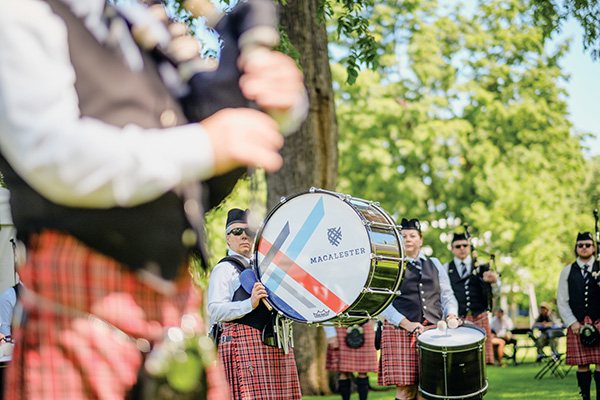
Learning the Language of Bagpipes
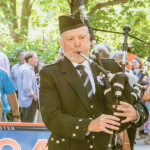 When President Suzanne M. Rivera and her spouse, Dr. Michael Householder, arrived at Mac in 2020, he jumped at the chance to take free bagpipe lessons offered by director of piping Mike Breidenbach ’96. “The sound of bagpipes has always fascinated me,” Householder says. But even with professional instruction, it’s not an easy instrument to learn, as he shares below.
When President Suzanne M. Rivera and her spouse, Dr. Michael Householder, arrived at Mac in 2020, he jumped at the chance to take free bagpipe lessons offered by director of piping Mike Breidenbach ’96. “The sound of bagpipes has always fascinated me,” Householder says. But even with professional instruction, it’s not an easy instrument to learn, as he shares below.
I sometimes joke that I have learned two languages out of my love for Sue: Spanish so I could communicate with her beloved grandmother, and bagpipes so I could be a part of the Mac family.
For the first six months, I learned on a practice chanter, which is similar to a recorder that kids play in school. I graduated to the full pipes and joined weekly rehearsals with the full band.
My first night with the band was a humbling experience. After I bumbled my way through “Amazing Grace,” Mike smiled reassuringly. “Don’t worry if it wasn’t perfect,” he said. “Everyone here has gone through the experience of playing with others for the first time. And we’re all excited that you’re here.”
In the three years since, I have been on the other side of this welcoming ritual at least a couple dozen times with brand new first-year students, soon-to-graduate seniors, alumni who played previously and returned to the band after years (sometimes decades) away, and people with no prior connection to the college who just want to learn the pipes.
For me, the highlight of our year is piping in the Commencement procession. There is nothing cooler than a graduating piper temporarily trading in their kilt for a cap and gown, and filling the air with “Scotland the Brave” for themselves and their classmates. In that moment, they embody something beautiful and so characteristic of Mac: a love of learning, pride in their growth, and a love for community that drives them to bring more joy into the world.
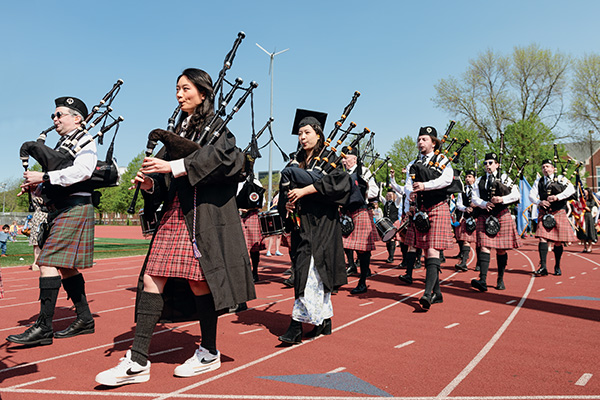
Dr. Michael Householder is a scholar of American literature and a member of the Macalester College Pipe Band. He is married to President Suzanne M. Rivera.
November 18 2024
Back to top